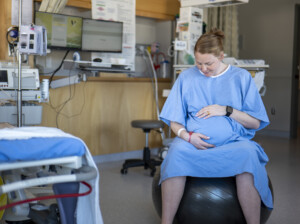Prodromal labor (pronounced pro-DROH-mull) is a variation of early labor. The mild to strong contractions women experience during prodromal labor feel more like actual labor than Braxton-Hicks contractions. By contrast, Braxton-Hicks contractions feel mild, occur on one part of the uterus, are somewhat random, and do not progress. They can usually be quelled by sleep, hydration, or a warm bath.
However, prodromal labor entails having contractions that become longer, stronger, and closer together, but with no change to your cervix.1 It is your body’s way of slowly preparing for labor and usually means the baby is coming very soon. However, prodromal labor differs from early labor because the cervix doesn’t dilate. In early labor, the cervix will dilate up to six centimeters.
Symptoms of Prodromal Labor
- Difficulty sleeping because of contractions
- Contractions that continue despite rest, hydration, and a warm shower or bath
- Lack of cervical dilation
- Contractions that are getting longer and closer together but without cervical dilation
- Your contractions begin to take a pattern but then dissipate
Best Ways To Manage Prodromal Labor
Managing prodromal labor will look different from mother to mother, but the suggestions below tend to be frequently recommended by professionals to women who experience this type of contractions. However, if life with your prodromal contractions feels unbearable, talk to your provider about taking medicine to help cope with your discomfort. Here are some other ways to manage your prodromal labor:
1. Talk to your birthing professional.
Tell your doctor, naturopath, or midwife about the contractions you are experiencing and ask for their advice.
2. Relax.
Ask your partner or friend to give you a massage to help you relax. Or visit a professional massage therapist who is certified in prenatal massage.
3. Try acupuncture.
Visit an acupuncturist who has experience and certification to work with pregnant women.
4. Get your stretch on.
Yoga and gentle stretching can help ease muscle tension and soreness associated with prodromal labor symptoms.
5. Have a soak.
A warm bath or shower with added essential oils like peppermint and lavender can help ease tension (be sure to check with your birth professional before using essential oils). However, if your contractions are strong, they may not ease the pain much.
6. Try a different position.
Try changing positions regularly until you find a position that feels most comfortable. Examples include lying on your side, sitting in a soft armchair, standing with support, or gently bouncing on a yoga ball.
7. Practice birthing techniques.
When prodromal labor starts, it’s also a great time to practice breathing techniques you will use in the delivery process. Try meditating or working on your out-breath technique, such as the one you might have learned in childbirth class, been taught by your doctor or midwife, or read about online.
8. Fill your belly.
Eat high-power, high-protein foods. Sometimes you may experience vomiting with prodromal labor symptoms—I know I did with my first child. However, if you are not nauseous, this can be a great time to indulge in a hearty meal to power up for the upcoming birth. Or, snack on dried fruit, almonds, nuts, granola bars, a bowl of oatmeal, scrambled eggs, a plant-based milkshake, or seaweed snacks.
9. Sing and dance.
Sometimes playing upbeat, happy, or otherwise soothing music can help mothers get through prodromal labor symptoms. You can gently walk and listen on headphones, dance gently and safely in your living room, or lie down and turn on your speakers.
10. Talk to your tribe.
Calling and speaking with a friend, loved one, healthcare provider, doula, or therapist can be a great way to process the emotional stress of prodromal labor. Sometimes the knowledge that you are loved and supported by people around you can help give you strength, motivation, and new strategies to get through the final days leading up to childbirth.
11. Stay hydrated.
Stay hydrated with water or coconut water. I drank a lot of coconut water before and after my pregnancies, which helped me stay hydrated and full of electrolytes. Plus, it tasted great! A few other power drinks for pregnancy and delivery include:
- Orange juice
- Pregnancy-safe tea with coconut milk and honey
- Electrolyte drinks (free of artificial ingredients)
- Bone broth
- Green drinks (fresh vegetable and fruit smoothies or juices)
12. Try positive visualization.
You can do this simply by closing your eyes and imagining a picture of you and your baby or your partner with your baby after he is born. You can also journal a positive visualization with words or make a picture.
Remember, prodromal labor means your baby is almost here, mama!














